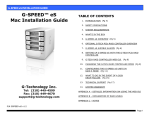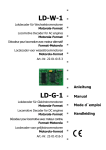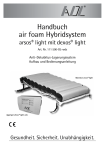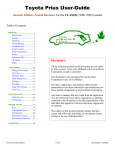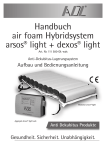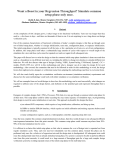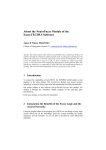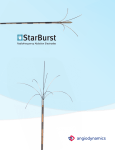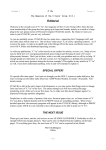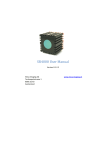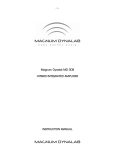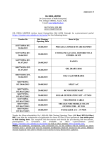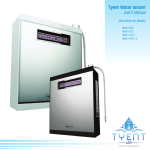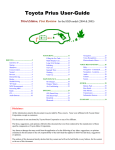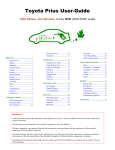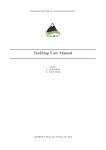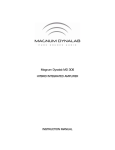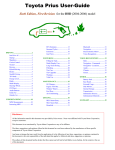Download Methods and Metrics
Transcript
! Toyota Prius Hybrid Display System Usability Test Report ! ! ! Methods!and!Metrics! Author' Shobana'Subramanian' ' Contributor' Daniel'Nissenbaum' ' ' 2 Table!of!Contents:!Methods!and!Metrics! ! Table&of&Contents:&Methods&and&Metrics&.....................................................................................................................................&2& Methods&and&Procedure&.....................................................................................................................................................................&3& Participant&Information&......................................................................................................................................................................&4& Lab&Configuration&..................................................................................................................................................................................&7& Pilot&Test&Configuration&......................................................................................................................................................................&9& Session&Procedure&...............................................................................................................................................................................&12& Session&Details&......................................................................................................................................................................................&19& Consent&Form&........................................................................................................................................................................................&21& General&Goals&and&Tasks&...................................................................................................................................................................&22& Usability&Metrics&..................................................................................................................................................................................&23& Subjective&Surveys!..........................................................................................................................................................!25& ! ! 3 Methods!and!Procedure! Usability testing included a Final and Pilot phase. FINAL In order to understand the ways in which different types of people interact with the interface, we tested using 3 different groups of people: People who have never driven a hybrid, people who drive a Prius, and people who drive another hybrid other than the Prius By dividing up the participants this way, we were able to detect different levels of knowledge, comfort with the system, and ability to use the interface to attain the goal of high gas mileage. All three groups were given similar goals and tasks in the usability test, with more detailed questions being asked of the Prius users. While all three groups recieved similar tasks and goals, they were presented in a different order, depending on which user group they belong to. In order to gain information from realistic driving conditions while providing a safe, controllable environment, the full usability test was conducted in a simulator rather than a traffic lot. By using a simulator, the researchers were able to control 15-30 minute long traffic conditions for each session. A simulator also allowed for easy collection of a larger range of objective data. PILOT To test the viability of the test procotols and procedures, a pilot was first conducted. The pilot had all the same goals and tasks but used a smaller number of participants. The participants were also aquaintances of the reseachers and were not compensated, thereby eliminating recrtuiment and screening related costs. A test car owned by one of the researchers was used, in lieu of the more expensive car simulator. Recording devices were also be drawn from the reseachers’ current resources. ! ! ! ! 4 Participant!Information! Participant Make-up FINAL Table 1: Participant Type Distribution in Final Test Participant Type Number of Participants No Prius Experience 8 Prius User 6 Other Hybrid User 6 Total Number of Participants: 20 PILOT Table 1: Participant Type Distribution in Pilot Test Participant Type Number of Participants No Prius Experience 4 Prius User 2 Other Hybrid User 2 Total Number of Participants: 8 Participant Groups: • • • Novice User: Participants who have never driven a Prius Prius User: Participanst who have driven a Prius for at least 1 year. Alternative Hybrid User: Participants who have driven a hybrid other than the Toyota Prius for at least 1 year. This group of users may include some participants who have driven a Prius at one point, but have not driven one regularly in the past year. Certain characteristics were spread evenly across the three participant types in order to counterbalance them. These characteristics included: • Age • Gender 5 • Amount of driving done per week A list of participants, which group they belong to, and what protocol they were given is shown in the Full Report in Appendix A PILOT The make-up of the group was as follows: Gender Female: 3 (37 %) Male: 5 (63%) Age 25 – 50 Avg=35.6 Amount of Driving per Week 41.85 miles per week day per participant Driving Tendencies N=4 Windows down N=4 A/C on Participant Screening Document In order to be included in this study, portential participants had to meet a basic criterion of: • A valid driver’s license • Knowledge of the area (San Jose, CA, & surrounding areas) • 20/20 vision, or corrected to 20/20 • Availability on the testing dates • Reliable transfortation to the testing facility Other data collected from potential participants included: • Age • Gender • Type of car • Average amount of driving per week • Experience driving a Toyota Prius or other hybrid car • Driving tendencies (uses A/C, follows speed limit, etc) A sample of our participant screener can be seen in Appendix C in the Full Report Participant Recruitment Pilot: The pilot test relied on a pool of volunteers aquainted with the researchers. Final: Our participant recuitment advertisements asked for participants to help out for consumer research on a hybrid car, and welcomed all current and non-users. It explained that the test was to be conducted within the safety of a simulator, and will, of course, be fun! Compensation was offered to participants who qualify and complete all session in the study. Length of individual sessions was descrbed to the potential participants. Contact information was also provided. 6 Our recruitment mainly took place through local posting websites such as Craigslist.org, as well as local print ads. Advertising was also done online via the Prius forums (www.priuschat.org/forums). Sample recruitment ads can be found in the Full Report in Appendix B. Reminder emails were sent to the participants 48 hours before their session time. An example of a reminder email can be seen in Appendix D. Participant Compensation For the Final test, participants were given $100 cash at the end of the completed session. If the participant did not show up for their session, no compensation was given. If a participant abandoned their session for any reason, compensation was not given. ' ' ' ' ' ' ' ' ' ' ' ' ' ' ' ' ' ' ' ' ' ' ' ' ' ' 7 Lab!Configuration! The Simulator: The usability test was carried out via a driving simulator. A simulator was used in order to be able to effectively control road conditions, traffic, as well as providing a much safer environment for the participant than driving the real car on the road. The simulator was equipped with a Toyota Prius seat, steering wheel, pedals, and a fully functional instrument panel. In place of the windshield will be a screen onto which road traffic was simulated. Driving Simulator The Observers: When the researcher is not in the room with the participant, they were in an adjacent room behind a one-way mirror observing the sesssion. Recording Devices: • A Camtasia screen recorder was used to record the interaction with the hybrid display system. • A camera was placed on top of the simulator, facing the participant to record facial expression. • A second camera, placed on top of the driving seat over the right shoulder of the participant, was focused on the buttons on the steering wheel used to change screens in the interface, and also had a view of the interface. • An eye tracker that can be installed on the computer was used to record eye movements. • Microphones were placed on the steering wheel of the simulator to record verbal information from the participants. • All information from the simulated windshield was recorded by the simulator software. 8 Video Cameras '''''''''''' Eye tracker installable on computers ! ' ! ! ! ! ! ! ! ! ! Microphone' ' ' 9 Pilot!Test!Configuration!! ' Parking Lot The testing was done on weekends in an empty parking lot of an office complex, located at the interection of Brokaw Road and Oakland Road in the north San Jose, CA. The location was easy to find. Intersection of Brokaw and Oakland, San Jose, CA Test Area: Empty Parking Lot ' ' 10 Views of the Parking lot A 1/4 mile long full loop of the parking was used for the driving portions of the test 11 Recording Devices Video cameras were used to record the session activities A video camera was placed on top of the dashboard (in a corner to avoid interference with driving) and facing the participant to record facial expression. A second video camera was set on the front passenger’s seat focused on the buttons on the steering wheel used to change screens in the interface, and with also with a view of the interface. The third camera on a tripod was set up on the back seat floor which captured the the interface itself' 12 Session!Procedure! FINAL The following procedures were used for all participants from each user group: Pre-Session Set-up Before the participants arrived for any session, the researchers verified that the test lab equipment was set up for a new participant. Initial Set-up with Participant One of the researchers greeted the participant in the reception office. The participant was asked to sign a consent form (see Appendix E in the Full Report) that gives the client consent to record audio and video of the session, and requires the participant to not disclose anything they would learn and observe during the sessions in the lab with another party. Participants were verbally given an initial session introduction. All recording instruments were then switched on in the simulator and its peripherals and the participant is taken to the test lab. What follows is an overview of 3 separate protocols for each kind of user. Each individual protocol can be found in the last section of the Protocols in Appendix F (New User), Appendix G (Prius User), & Appendix H (Alternative Hybrid User) in the Full Report. Novice User Procedure In the lab room, the participant was told they would be interacting with a driving simulator and would be required to do driving related tasks. They were then asked to perform the driving tasks as they normally would, following normal driving rules. The participant was then seated in driving seat of the Reception Area 13 simulator. The participant’s posture was adjusted so it synchs with the eye tracker, and the cameras. The participant was given basic instructions about how to start the car. The first exercise was a free-form task. A manual was left within reach. The user was told to interact with the car in whatever manner they choose, and that they were free to explore and perform any driving tasks they Simulator set-up in the may choose. lab room The researcher then returned to the room and instructed the user on the next task after the designated time is up. The next exercise was a goal-based activity. The participant was given instructions about a local route they will have to drive on the simulator. The participants were told they have flexibility in how they would drive the route, and to perform the driving tasks are they normally would in a car. The researcher then left the participant to complete the task. Upon completion of the goal-based portion, the researcher returned to the lab room and began the taskbased activity. Participant drives the simulator in the free-form session, and the designated route for the goal-based activity Here, the participant was led through the features of the interface, answering questions posed by the researcher using their understanding and perception of how the interface functioned The researcher then informed the participant that the session activities were complete and that their feedback would be collected. The simulator then brought up the survey questions. The participant then read the screen. In addition, the researcher verbally read out the questions twice. The participant responded verbally. Alternative Hybrid User Procedure The procedure was the same for this user, with the exception that the goal-based activity was completed first, Researcher asks the participants questions about the interface and their subjective responses 14 followed by the task-based, freeform activities, and finally feedback gathering. The feedback session included additional questions. Prius User Procedure The Prius User procedure included similar activities but with a focus on more complex information and tasks. The researcher was in the lab room for all the activities, providing instructions and asking questions. The participant was given a full view of the interface at all times, with no interruptions while tasks were being completed. The session started with an interview and task-based activities with the participant answering questions involving a complex experience with the system. Researcher with Prius user: Interview about the interface followed by goal-based driving activities on the simulator. This was followed by the goal-based activity with specific driving instructions, including directions to drive in a manner that would be considered fuel-efficient. The procedure then ended with a feedback session, conducted in a similar fashion as the other user protocols, but with a focus on display preferences and value of the interface for the user. Check Out When the sessions in the lab room were finished, the researcher thanked the participant for their participation and lead the participant to the reception area. Here, the participant received their compensation and was asked to sign a payment log confirming receipt of payment. See Appendix J in the Full Report for sample payment log. The researchers then saved all recordings and begin setup for the next participant. Recording Participant’s entire interaction with the simulator was recorded by the driving simulator software, Camtasia screen recorder, eye tracker software, and the cameras. All sessions completed! 15 The verbal response of the participants was recorded on the researcher’s log on the individual protocols and the cameras and microphone. PILOT The modified session procedure used for the Pilot are as follows Pre-Session Set-up Before the participants arrived for any session, the researchers verified protocol and that the test car and recording equipment is set up for the new participant. Test Car in lot being set up Initial Set-up with Participant Introductions were made and the participant was greeted in the parking lot. The participant was requested to sit in the driver’s seat of the test car. Participants were verbally given an introduction to the sessions and activities involved. The participant was asked to sign a consent form that gives the client consent to record audio and video of the session, and requires the participant to not disclose anything they would learn and observe during the sessions with another party. Greeting the participant All recording instruments are switched on in the car. What follows is an overview of 3 separate protocols for each kind of user. (Appendiix I has the modified protocols) Participant gets settled into the test car 16 Novice User Procedure The participants were told they would be interacting with a Toyota Prius and will be required to do driving related tasks. They were asked to perform the driving tasks as they normally would, following normal driving rules. They were reminded to wear seat belts and asked to adjust any car settings as per their needs. The participants were given basic instructions about how to start the car. They were told to take their time getting to know the car and when they were ready to take a few rounds around the parking lot. The car manual was left within reach. The goal-based activity commenced when the participant started to drive. The moderator gave basic instructions about how to navigate around the parking lot as required. As the participant drove, at set intervals, the participant answered questions to situational awareness probes. Upon completion of the goal-based portion, the moderator asked the participant to park the car in a parking spot. The task-based activity was conducted next. Here, the participant was led through the features of the interface, answering questions posed by the moderator to test their understanding and perception of how the interface functions. The moderator pointed to particular screens and asked questions sometimes twice to make sure the participant understood. The moderator then informed the participant the session activities were complete and that their feedback would be collected. The researcher Participant answers probes during driving task 17 asked questions out aloud, sometimes twice to make sure the participant understood. The participant responded verbally. Alternative Hybrid User Procedure The procedure was the same as the novice user, with the following exceptions: The alternative hybrid user completed a freeform activity for 5 minutes where they explored the display screens by themselves with the car in a parked mode. The final survey included questions comparing their experience with their current cars. Participant answers questions about the interface in parked mode The order of activities was also different: the goal-based activity came first followed by the task-based, the freeform activity, and finally feedback gathering. Prius User Procedure The Prius User procedure included similar activities but with a focus on more complex information and tasks. The procedure started with an interview and taskbased activities with the participant answering questions involving a complex experience with the system. This was followed by the goal-based activity with specific driving instructions, including directions to drive in a manner that would be considered fuel-efficient. The procedure ended with a feedback session, conducted in a similar fashion as the other user protocols, but with a focus on display preferences and value of the interface for the user. Survey interview and feedback gathering finishes off the sessions 18 Check Out When the sessions were complete, the researchers thanked the participant for their participation. The researchers checked all recordings and began set-up for the next participant. All sessions completed! Recording Participants’ entire interaction was recorded by 3 cameras. The verbal response of the participants was also recorded on 2 researcher logs: One capturing behavior and time stamping key sections, and other log recording answering participant’s answers to questions posed. The back seat research team 19 Session!Details! Session Activities The session activities were ordered differently for each of the User Groups, but typically consisted of five sections: • Introduction/consent form: Upon arrival, participants signed the informed consent form. After signing, they were brought into the simulator room, where all equipment was callibrated to the specific participant. ● Free-form. Participants were given basic instructions were then left to interact with the car simulator on their own. (Exception: Not used for Prius User). ● Goal-based activity: Participants performed driving tasks on the simulator/in car in parking lot ● Task-based activity: Participants were led through the features of the interface, performing feature identification and related tasks, one task at a time, with all participants following the same logical temporal order for each type of protocol. ● Post-test survey and Open-ended feedback: Participants verbally answered a survey on their overall subjective experience with the interface. Session Timing FINAL Each participant session lasted exactly 1 hour. The order of session activities varied depending on the participant type as follows: • Novice User: o 10 minutes: Sign-in &calibrate simulator o 10 minutes: Free-play with interface o 20 minutes: Goal-based driving simulation o 10 minutes: Task-based activities o 10 minutes: Post-test survey & participant feedback • Prius User: o 10 minutes: Sign-in &calibrate simulator o 25 minutes: Interview and Task-based activities o 15 minutes: Goal-based driving simulation o 10 minutes: Post-test survey & participant feedback • Alternative Hybrid User: o 10 minutes: Sign-in & calibrate simulator o 20 minutes: Goal-based driving simulation o 10 minutes: Task-based activities o 10 minutes: Free-play with interface 20 o 10 minutes: Post-test survey & participant feedback PILOT Total session time averaged 30-35 minutes. The order of session activities varied depending on the participant type as follows: • Novice User: o 2 minutes: Sign-in & calibrate recording devices o 5-10 minutes: Goal-based driving acitivity o 10 minutes: Task-based activity o 10 minutes: Post-test survey & participant feedback • Prius User: o 2 minutes: Sign-in & calibrate recording devices o 15 minutes: Interview and Task-based activity o 5 minutes: Goal-based driving activity o 10 minutes: Post-test survey & participant feedback • Alternative Hybrid User: o 2 minutes: Sign-in & calibrate recording devices o 5 minutes: Goal-based driving activity o 10 minutes: Task-based activity o 5 minutes: Free-play with interface o 10 minutes: Post-test survey & participant feedback From the Full Report: Each individual protocol can be found in the last section of the Protocols in the in Appendix F (New User), Appendix G (Prius User), & Appendix H (Alternative Hybrid User From the Full Report: The modifications to the protocol for the pilot test are noted in Appendix I ! ! ! ! ! 21 Consent!Form! All participants signed an informed consent form prior to taking part in this usability test. The document was presented to the participant upon arrival, and was read aloud to them by the researcher as they read it to themselves. Within the informed consent form, it was explicitly stated that the participant had the right to leave the study at any time for any reason, but that uncompleted sessions would result in a loss of the $100 compensation. For the PILOT, the consent form process was followed as well. A sample of the Informed Consent Form can be found in Appendix E of the Full Report ! ! ! ! ! ! ! ! ! ! ! ! ! ! ! ! ! ! 22 General!Goals!and!Tasks!! FINAL There was a number of general goals and tasks that were asked of the participant throughout the session. During the Free-form section of the usability test, goals and tasks included: • Exploring the interface • (Optional) explore the user manual General goals and tasks during the Goal-based section of the usability test included: • Driving from Point A to point B • Providing various readings while driving, including: o Current miles per gallon, o Current miles her hour o Whether car running on electric or batter o Amount of power left on battery • Maintaining safe driving behavior and situational awareness • Attaining a high level of fuel efficiency General goals and tasks during the Task-based portion of the usability test included: • Providing various readings, including: o Odometer o Average miles per gallon o Average miles per hour o Distance until empty fuel tank • Describing to the resarcher how to navigate to specific screens • Describing to the researcher what information is presented on certain screens of the interface General goals ands tasks during the survey and feedback activity included: • Describing to the researcher preferences, points of complications, and recommedations. PILOT For the Pilot, the same goals and tasks were followed, with the following exception: The Goal-based tasks were conducted in a parking lot. ! ! ! ! ! 23 Usability!Metrics! FINAL Sources of Data: Information recorded on cameras and microphones located throughout testing area, Camtasia screen recordings, traffic simulation software, eye tracking recordings, and researcher’s log on indivual protocols. Measures of Performance: All performance measures were based on the Goal-based activity and include: • Situational Awareness vis-à-vis interface: o While driving, answers to probes on current miles per gallon, miles her hour, and whether car running on electric or battery, amount of power left on battery: measured by accuracy, number of glances and time taken. • Overall Situational Awareness and Allocation of Attention : o Overall number of glances towards interface: Measured against standard: 2.7 glances is maximum allowable. o Driving Accuracy: Lane control (staying close to center of lane, maintaining safe distance between cars), Turn/Exit Errors, Lane Change Execution (signalling,checking traffic, executing smooth transitions between lanes without jerks or mishaps), Accidents • Fuel-efficient Behavior: Number of times/Amount of time ECO light appears, Amount of time power charged (CHG versus PWR on HybridSystem Indicator) , Average miles per gallon on trip. • Time taken to complete tasks • Task success rate: Measured against standard: there can be zero accidents Measures of Behavior: • Ease of learning and remembering where information is diplayed: Number of features identified in Task-based activity • Efficient to use: Amount of time and number of screen changes needed to find information on Task-based activity • Positive and Negative Responses: Tabulation of all behaviors observed (including general body posture, words spoken, honking) and quantifying of any repeated behaviors by individual and across participants- based on both Goal and Task based activities Measures of Satisfaction: The Post-test Survey will ecilit user feedback on the interface in terms of : • Information clarity and acceptability • Fun to use and Purchase worthiness • User preferences and grading of different screens • User suggestions on improvements to interface • User perception of their task performance 24 PILOT Sources of Data: Information recorded on 3 cameras located in the car, and researcher logs for each individual based on appropriate protocols- one recording answers and the other behavior. Measures of Performance. • Situatuational Awareness Probes vis-à-vis interface (Novice and Alternative Hybrid Users protocols only) included: 1) What is the current miles per gallon? (ask twice at different stages) 2) How fast are you driving? 3) Is the car running on gas or electric? 4) How much energy is currently left on the battery? 5) What is your current miles per hour? • Fuel Efficiency knowledge with Situtational Awareness (Current Users only) probes included: 1) Begin Driving in most efficient mode (EV)? 2) Switch to ECO mode 3) Check if we are running out of gas 4) What is the Current MPG? 5) Go to the energy monitor display Drive to show that the flow of energy is going from the battery to the electric motor to the gas engine. 6) Next, show the flow of energy going in reverse: from the gas engine to the electric motor to the battery. 7) Drive in most effective way to recharge battery The data was tabulated for each probe above are as follows: o Accuracy of responses o Number of glances towards interface (measured against standard: 2.7 glances is maximum allowable; Eye Pursuit and Head Turns counted) o Time Taken to answer Measures of Behavior: • Ease of learning and remembering where information is diplayed: Number of features identified in Task-based activity • Positive and Negative Responses: Tabulation of all behaviors observed (including general body posture, words spoken) and quantifying of any repeated behaviors by individual and across participants- based on both Goal and Task based activities Measures of Satisfaction: • In the Post-test Survey users assessed the interface on the basis of: o Information clarity and acceptability o Fun to use and Purchase worthiness o User preferences and grading of different screens o User suggestions on improvements to interface o User perception of their task performance 25 Subjective!Surveys! Subjective surveys were administered at the end of each usability test session. Questions were presented to the participants on the screen of simulator while they are simultaneously read aloud by the observer. When applicable, a Likert Scale will accompany questions on the screen. Responses were recorded via audio and video, as well as through notes taken by the researcher. The participant was given 10 minutes to respond to the survey questions. PILOT While seated inside the car, with the engine on, the moderator asked the questions verbally and the participant answered verbally. Survey by User Type New and Alternative Hybrid User: • What did you think of the hybrid display? • If applicable: Why didn’t you play around with the car or the manual before starting to drive? • Did you find yourself more aware or concerned with your mileage than you normally would be? • How do you feel about the placement of the screen itself? • How easy/difficult was it to find information on the display while driving? • Of the screen options you saw on the display, which one was the easiest to read? Why? • Of the screen options you saw on the display, which one would you least use? Why? • What did you think of the tracer display? • Was there anything in particular you strongly did not like? • On a scale of 1-5, please rate your concern for the car’s fuel consumption while driving the car? 1=very little concern, 5=high concern • On a scale of 1-5 please rate how distracting was the hybrid display. 1= not distracting, 5= very distracting • If above is yes, what did you find the most distracting? • On a scale of 1-5, how confident are you in driving this car after this experience? 1= low confidence, 5= high confidence • On a scale of 1-5, can you rate how appealing the interface was for you? 1= unappealing, 5= very appealing • On a scale of 1-5, can you rate whether you thought it was fun to drive the car? 1= no fun, 5= great fun • Having now driven the car, could you describe to me how the hybrid system works? • Is it important for you to know how the hybrid system is working at any given moment? Why or why not? • If you could change the display, what information would you take out? What information 26 • • would you add? Would the hybrid display system affect your decision to purchase a Prius? In what ways? Any final thoughts? Additional Probe for Alternative Hyrbid User: • How would you compare the Prius to your current Hybrid? What are the Pros and Cons? Current User: ● How do you feel you did with the tasks? Why? ● How do you feel about the placement of the screen itself? ● How easy/difficult was it to find information on the display while driving? ● Is there anything you find distracting on the interface? ● What improvements would you make to the hybrid display? ● What is your overall satisfaction with your Prius? ● Of all the screens, which is most important to you? Why? ● How comfortable do you feel using the other 2 screens? ● On a scale of 1-5, how acceptable was the Hybrid System Indicator Screen? 1= not acceptable, 5 = most acceptable. Why? ● On a scale of 1-5, how acceptable was the Energy Monitor Screen? 1= not acceptable, 5 = most acceptable. Why? ● On a scale of 1-5, how acceptable was the Interval Consumption Screen? 1= not acceptable, 5 = most acceptable. Why? ● On a scale of 1-5, how acceptable was the Past Record Screen? 1= not acceptable, 5 = most acceptable. Why? ● On a scale from 1-5, how valuable to your driving do you find the information displayed to be? 5=high ● What, if anything, would you add to the interface? Why? ● What, if anything, would you remove from the interface? Why? ● Are there any functionalities that you have learned at some point, but forget or neglect to use while driving? ● How would you rate the interface design of the Prius? ● Having owned and driven this car, could you describe to me how the hybrid system works? ● Is it important for you to know how the hybrid system is working at any given moment? Why or why not? ● Any additional concerns that have not been previously addressed?! !!



























